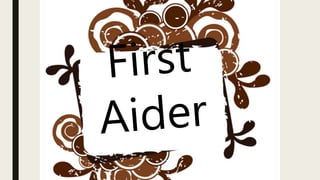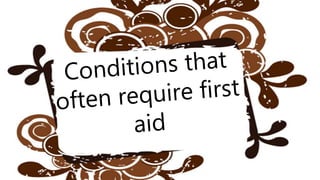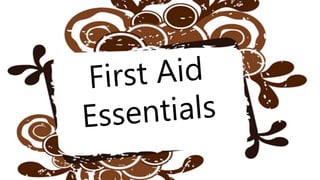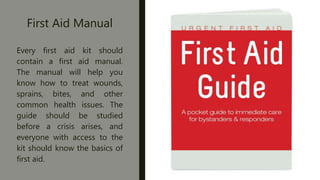Rcy
- 1. RED CROSS YOUTH – B S.Y 2016 -2017
- 3. First aid is the assistance given to any person suffering a sudden illness or injury, with care provided to preserve prevent the condition from worsening, and/or promote recovery.
- 5. 1. It is the bridge that fills the gap between victim and the physician. 2. It ends when the services of the physician begins. 3. It is not intended to compete with nor take the place of a physician.
- 7. Preserve life: the overriding aim of all medical care which includes first aid, is to save lives and minimize threat of death.
- 8. Prevent further harm: also sometimes called prevent the condition from worsening, or danger of further injury, this covers both external factors, such as moving a patient away from any cause of harm, and applying first aid techniques to prevent worsening of the condition, such as applying pressure to stop a bleed becoming dangerous.
- 9. Promote recovery: first aid also involves trying to start the recovery process from illness or injury, and in some cases might involve completing a treatment, such as in the case of applying a plaster to a small wound.
- 11. Some people undertake specific training in order to provide first aid at public or private events, during filming, or other places where people gather. They may be designated as a first aider, or use some other title. This role may be undertaken on a voluntary basis, with an organisation such as the Red Cross, or as paid employment with a medical contractor. People performing a first aid role, whether in a professional or voluntary capacity, are often expected to have a high level of first aid training.
- 13. 1. Observant - should notice all signs 2. Resourceful - makes use of things at hand 3. Gentle - should not cause pain 4. Tactful - should not alarm the victim 5. Sympathetic - should be comforting 6. Cheerful - inspires and develops confidence
- 15. 1.Bone fracture 2.Burns 3.Cardiac Arrest 4.Choking 5.Childbirth. 6.Cramps 7.Drowning 8.Toothache 9.Wounds (bleeding – lacerations) 10.Poisoning 11.Heart attack 12.Stroke
- 17. First Aid Manual Every first aid kit should contain a first aid manual. The manual will help you know how to treat wounds, sprains, bites, and other common health issues. The guide should be studied before a crisis arises, and everyone with access to the kit should know the basics of first aid.
- 18. Tweezers Tweezers are an important tool to have in any first aid kit regardless of how basic your kit is. Tweezers can be used to remove debris such as glass, dirt, or splinters from a wound. They can also be used to remove stingers left behind by bees.
- 19. Alcohol Swabs Alcohol swabs are used to clean the infected or wounded area before antibiotic ointment or bandages are placed on the area. Alcohol swabs may also be used in conjunction with anesthetic swabs and can be used to sterilize tweezers if needed.
- 20. Antibiotic Ointment Antibiotic ointment can be used to treat many types of conditions and will aid in the proper healing of the wound area. Antibiotic ointment also helps to keep infection out of the wound and should be administered after the injured area has been thoroughly cleaned.
- 21. Adhesive Bandages Adhesive bandages in multiple sizes should be part of a first aid kit. Consider purchasing a box of assorted- size bandages and putting a few of each in the kit. Traditional size bandages are needed more often than the largest and smallest sizes, so it's a good idea to add a few extra of these, just in case.
- 22. Gauze Pads Adhesive bandages aren't always large enough to cover a wound, which is why it's crucial to have gauze pads in a first aid kit. Gauze pads can be fashioned into a bandage or used to absorb blood. Gauze pads come in many sizes and each kit should include an assortment.
- 23. Medical tape Medical tape is used to secure gauze pads or wraps when they are being used as a bandage. This tape is designed not to leave residue behind and usually comes in a long roll.
- 24. Elastic Bandages Elastic bandages help keep a sprained joint immobile and reduce swelling. Elastic bandages come with either hook-and-loop or metal fasteners to keep them in place. These flexible bandages can be wrapped around ankles, knees, wrists, and elbows until you can get to a doctor. These bandages vary in width from one to six inches.
- 25. Pain Relievers Each first aid kit should include a selection of pain relievers. Aspirin-based and non-aspirin pain relievers should be included in the kit at all times. If there are children in the house, be sure to include pain relievers meant for them. These will come in handy when treating a deep wound or scrape and can also be used to relieve minor aches and pains.
- 26. Instant Cold Packs To prevent swelling, many health care professionals recommend icing an injury. A one-time, instant-use cold pack does not become cold until the seal on the packaging is broken and the material inside is activated. Cold packs of this type are ideal for basic first aid kits because they don't require refrigeration.

























